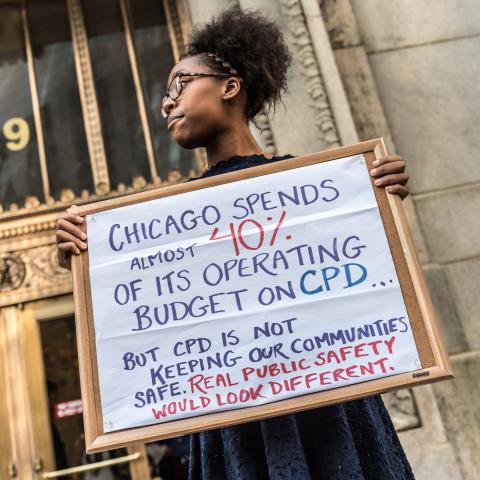The Chicago Alternative Policing Strategy (CAPS) has long been touted by law enforcement and elected officials as an effective means of addressing the discord between police officers and minority communities. However, The Black Youth Project 100 (BYP 100), a social justice organization located in Hyde Park (5733 S. University Ave.), has recently partnered with other non-profits in releasing a report that rebukes the notion that CAPS has been anything but destructive to Chicago’s most vulnerable communities.
In a Sept. 21 Kenwood community meeting meant to address a spike in neighborhood violence, 2nd District Community Policing Sergeant Monica Davis reprimanded community residents for not attending area CAPS meetings. For Davis, a strong community presence at these meetings would mean a smoother relationship with the neighborhood and allow for more effective ways of identifying and acting on criminal behavior.
“We need you all to attend your local beat meetings,” Davis said. “You’re missing out on so much information.”
However, in the “Counter-CAPS Report: The Community Engagement Arm of the Police State,” released Oct. 28 by multiple organizations at a City Hall press conference, participating activists claim that the Chicago Police Department (CPD) has much more to gain through CAPS meetings than do community members. The report argues that instead of providing communities with meaningful control over the police, CAPS meetings employ a self-selecting group of neighborhood residents, who are frequently gentrifiers, to work with police to deflect criticism and build local support for tactics that unnecessarily criminalize young people of color.
“Despite its more palatable label,” the report states, “Chicago’s ‘community policing’ program is used to provide political cover for aggressive enforcement of so-called ‘quality of life’ crimes‚ and even for the physical displacement of people of color from gentrifying neighborhoods.”
The report furthers that, contrary to its intention, CAPS has contributed to minority distrust of police. An alternative solution, the report states, would be the redistribution of resources from the CPD and programs like CAPS to social service organizations in underserved communities.
JeNae’ Taylor, a member of BYP 100, said that community policing programs such as CAPS are unable to quell the city’s violence because they don’t address its root causes.
“Why are people shooting?” asked Taylor. “It’s because their needs are not being met. Let’s think about how this started. If we put more police outside, what will that actually do? Will it help meet the needs of all the members of your community? We need to build structures to continue to meet those needs.”
Miriame Kaba, a member of We Charge Genocide-the organization that spearheaded the Counter-Caps Report, said that the demographics of CAPS meeting attendees says a lot about who the program is meant to serve.
“You become a reporter for the cops,” Kaba said. “I don’t think it’s accidental that so few people show up. I think that the people who show up are mostly homeowners, mostly property owners, mostly white and very much afraid.” Kaba continued. “CAPS meetings are nefarious in gentrifying communities. They work as a push-out mechanism. When you think of community policing, it’s a misnomer, they’ve empowered a new arm of the community to be the gatekeeper of the community.”
A CPD CAPS coordinator was not able to be reached for comment on the recently released report.
The Counter-CAPS Report comes shortly after President Barack Obama urged a renewed dedication to community policing at the International Association of Chiefs of Police here in Chicago. At the convention, Obama did make one statement, however, that seemed to voice support for the underlying beliefs guiding the activists who’ve compiled the Counter-CAPS report.
“If we’re serious about protecting our communities and supporting our police departments,” Obama said, “then let’s invest in more opportunity, and let’s try to stop more crime before it starts. Let’s go after the racial disparities at the root.”
To view the full Counter-CAPS Report, visit wechargegenocide.org.


Spread the word